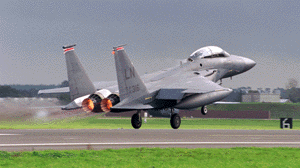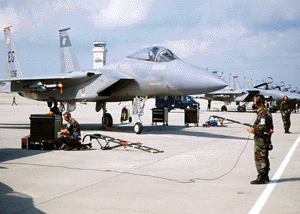Modern air forces spend tremendous money to purchase and maintain combat aircraft, which are costly to deploy and operate overseas. However, when aircraft are needed for combat they spend most of their time on the ground because air crews need time to eat, rest, and sleep. As a result, expensive attack aircraft normally make just one sortie a day and this assumes squadrons are fully manned. Squadrons can increase this rate for a few days until fatigue becomes a problem. If a squadron is committed for several weeks even one sortie a day per aircraft becomes difficult as problems of illness, injury, and demands mount for a weekend off-duty.
 Air Forces can double their combat power by adopting
a "Double Aircrew" concept, where two squadrons of personnel are
assigned one squadron of aircraft. The two squadrons would function independently, probably a "day"
squadron and a "night" squadron. There would be some overlap in administration and maintenance, but the
pilots work as separate squadrons. In high-tempo combat as aircraft return from a mission,
a "fresh" air and ground crew is preparing for another mission.
A pilot debriefs, gets something to eat, and goes to bed
while "his" aircraft takes off on another combat mission. The
"double-crew" concept is not just aircrew, it requires twice the
number of ground support personnel.
Air Forces can double their combat power by adopting
a "Double Aircrew" concept, where two squadrons of personnel are
assigned one squadron of aircraft. The two squadrons would function independently, probably a "day"
squadron and a "night" squadron. There would be some overlap in administration and maintenance, but the
pilots work as separate squadrons. In high-tempo combat as aircraft return from a mission,
a "fresh" air and ground crew is preparing for another mission.
A pilot debriefs, gets something to eat, and goes to bed
while "his" aircraft takes off on another combat mission. The
"double-crew" concept is not just aircrew, it requires twice the
number of ground support personnel.
The US Navy experimented with this concept a few years ago and it was a success. However, the idea was never adopted because more manpower was required. The solution of cutting the number of squadrons and aircraft was not considered because it upsets career military men. In addition, pilots don't like the idea of sharing "their" aircraft, most pilots in the Navy even have their names painted on the side.
Pilots must overcome old habits and recognize the advantages of double crews. F-22s don't need rest. One double-crew squadron of aircraft can conduct almost the same number of missions as two squadrons. This means the number of aircraft needed to purchase is cut in half, the amount of fuel to deploy them overseas is halved, and the amount of hangar space is halved. Funds to upgrade aircraft with the latest electronics is solved with a smaller inventory.
 Double aircrews are a solution to US Air
Force funding problems. The F-22 costs twice as much as the F-15C, but
the Air Force claims that it is twice as good. Therefore, the Air Force
can cut its number aircraft in each squadron from 24 to 12 and adopt
the double-crew concept for F-22 squadrons by keeping the same manning levels
for 24 aircraft. All squadrons can benefit from double aircrews. For example, the USA does not
have the airlift needed to support the rapid deployment of major ground forces.
Since funding is not available to form dozens more squadrons, the solution is to
train more aircrews. If the existing fleet of transports can fly twice as
many missions with extra ground crews that allow maintenance at all hours, airlift capacity
doubles.
Double aircrews are a solution to US Air
Force funding problems. The F-22 costs twice as much as the F-15C, but
the Air Force claims that it is twice as good. Therefore, the Air Force
can cut its number aircraft in each squadron from 24 to 12 and adopt
the double-crew concept for F-22 squadrons by keeping the same manning levels
for 24 aircraft. All squadrons can benefit from double aircrews. For example, the USA does not
have the airlift needed to support the rapid deployment of major ground forces.
Since funding is not available to form dozens more squadrons, the solution is to
train more aircrews. If the existing fleet of transports can fly twice as
many missions with extra ground crews that allow maintenance at all hours, airlift capacity
doubles.
During wartime, trillions of dollars worth of aircraft should not be parked because fresh crews are not available. Aircraft don't need rest, they should be flying, loading, or under repair. Some may argue that extra crews become available when aircraft require several days to fix. On the other hand, people break down too and need time off because of illness, injury, or personal problems. In addition, crews cannot work every day for months during a long war. Double aircrews allow a commander to permit one squadron of personnel several days off for rest and recreation because another squadron of personnel is available. Double air crews is not a complex idea, just a concept that increases airpower and saves money.
©2015 www.G2mil.com